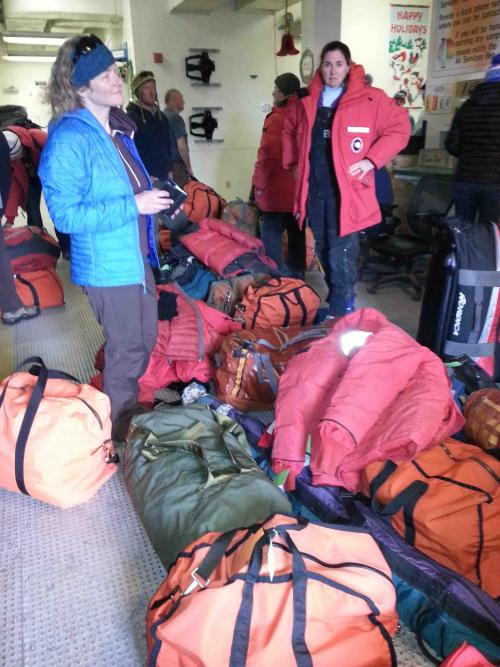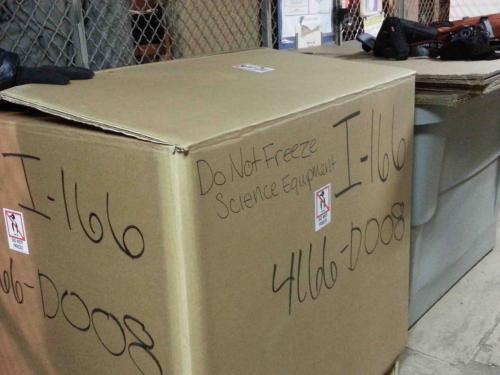The time has come to leave the comfortable and familiar life at McMurdo Base, and head for our remote field camp at WAIS Divide.
The process of flying in Antarctica is so different from anywhere else I've been that it feels worth a post of its own.
So here we go...
Step 1: Fixed Wing Meeting
Taking a flight inside of Antarctica begins with a meeting with your "Fixed Wing Coordinator." Planes in Antarctica are not called planes – they are called Fixed Wing Transport, because their wings don't move. They are fixed, you see... as opposed to Helicopters, which are "Rotary Winged," but mostly called Helos (pronounced Hee-lows).

On Wednesday, December 10, we had a meeting with our Fixed Wing Coordinator, in which she asked us our names and told us that we were scheduled to fly out on the weekend of December 20-21.
We were expecting to reach WAIS Divide by December 15. We asked her to clarify.
She did.
They plan flights around the weekend that follows it, and as long as we fly within the week, we are considered "on schedule."
Well that's reassuring!
So she told us that Monday, December 15 was a possibility, and to get ready accordingly.
Status: Completed December 10, 2014
Step 2: Cargo
If we were flying Monday, all of our Cargo had to be checked in 3 business days prior, so that gave us less than 24 hours.
All day Thursday, the team packed boxes of science equipment and other field equipment that we would need for our time at WAIS Divide, but did not need to carry with us on our flight.
This is classified as "Cargo" and gets shipped as space becomes available. It might go before us or on the same plane as us, hopefully arriving around the time we do.
Once items are packed, labeled (including noting whether they are allowed to get frozen or not!), weighed, wrapped onto pallets, and recorded into "the system" using two sets of paperwork, they are taken away by forklift... only to be seen again once we get to WAIS.


It's a time-consuming and tedious affair, but once over, we accomplished, and officially prepared for the flight on Monday.
We had 3 days now to do everything we needed to do at McMurdo, before heading out to WAIS.
Status: Completed December 11, 2014
Step 3: Bag Drag
The night before your flight is scheduled to take off you do what is called the "Bag Drag." This is basically what it sounds like.
We drag all of our bags, both check-ins and carry-on, plus all of our Extreme Cold Weather (ECW(abbreviation) Extreme Cold Weather clothing) gear that we are required to wear on flight, up(hill, both ways, in two feet of snow!) to Building 140. (I stay in Building 155.) All of our stuff, our gear, and even ourselves are weighed.

Although we are allowed to keep our carry-on and ECW(abbreviation) Extreme Cold Weather clothing until the flight takes off, we have to deposit our check-in luggage, so it can get palletized. This means that it gets loaded onto a big pallet and plastic wrapped into place, to be loaded into the middle of the LC-130.
Our bag drag, scheduled for Monday, December 15th (yes, we were already delayed from the Fixed Wing Coordinator's prediction), was cancelled.
Since there was a Congressional Delegation coming in on Tuesday, December 16, they did not even pretend that we might be prioritized that day.
Bag Drag was rescheduled for Wednesday, December 17th. Luckily, when it finally arrived, it went off without a hitch.
Status: Completed December 17, 2014
Step 4: Checking The Manifest
Once your check-in bags are gone, you cannot get them back. So until your flight takes off, you live with whatever you have in your carry-on bag. Hopefully, you were thinking ahead, and saved your toothbrush, some soap, clothes, and whatever else you'd need for another day... or week.
Although you know that your flight is scheduled for the next day, you don't know what time until it gets posted.
So we watch these big screens that are in the buildings to see if our flight pops up. It will either show up in one of three ways: with a flight time listed, as TBD, or as cancelled.

Also, since flights from the previous day(s) may or may not have taken off, even if your flight is scheduled, you may or may not be on it. So we watch another screen for the "Manifest" or the passenger list, to see if our names appear.

Status: It's complicated
*Completed December 14; *Revoked December 15; *Unknown December 16; *Completed December 17; *Revoked December 18; *Revoked December 19; *Unknown December 20; *Unknown December 21;
Step 5: Transport
If your flight actually gets scheduled to take off on the day you expect and your name is among the passengers, you are given a reporting time. This is the time when you are to report back to Building 140 with your carry-on bags, wearing all of your ECW(abbreviation) Extreme Cold Weather clothing gear to get transported to the airfield for your flight.
Transportation happens on Ivan The Terra Bus, and can take anywhere from 15 minutes to 1 hour, depending on which airfield you are supposed to leave from.

Our first Transport time, scheduled for December 18, was cancelled 30 minutes beforehand, once we had packed all of our stuff, cleaned our rooms, and were getting ready to strip our beds of linens.
Our second Transport time, scheduled for December 22 at 7am was cancelled one hour beforehand.
Status: Pending December 23 * Scheduled December 18 * Revoked December 18 * Scheduled December 22 * Revoked December 22 * Scheduled December 23
Step 6: Airfield
DISCLAIMER: From this point forward, the rest of this blog is based on hearsay. I have not yet actually experienced Steps 6 or beyond at the time of writing.
From what I have heard...
You get to the airfield, and board your aircraft. Then you wait...
... and wait,
... and wait some more.
Maybe the plane will turn on.
That makes it feel official. You might actually go somewhere then.
Or, if you are on a flight like one of my roommates last week, you will be informed that the incoming flight that was supposed to land decided, when it was half an hour away from McMurdo, to turn around and go back to New Zealand because of high winds. Since that flight did not land, your flight cannot take off. Each plane needs to be replaced with another one, or they can't send it away. There always has to be one plane on the ground in Antarctica, in case of the need for an emergency Medical Evacuation.

Status: Light at the end of the tunnel. I haven't gotten there, but I believe it exists.
Step 7: Taking off
If you are one of the lucky ones, your plane turns on and stays on, and you actually do take off.
But don't get excited yet. It ain't over till it's over.
Whether and where you land is a whole different story!
Status: Pipe dreams
Step 8: Landing
If you run into rough weather conditions that prevent you from landing, you could either "boomerang" (turn back to where you came from) or "bounce" (go somewhere else entirely).
Apparently, flights from the South Pole that can't make it all the way to McMurdo often "bounce" to WAIS Divide.
If that's the case, you will be laid over there until your flight takes off. The airline will not give you hotel vouchers or meal vouchers, though! You might get a tent to sleep in and some leftovers, if you are lucky.
Let's assume we are truly blessed, and our flight does actually land... in our desired location.
Hooray!!
We have arrived... but where's our stuff?
Status: Uhhh...what?
Step 9: Baggage Claim
You attend an orientation session first. They tell you a bunch of stuff you need to know about living in camp. Sometime at the end of that, they tell you where to go and pick up your checked bags.
You will have a very narrow window to make it there before they close. If you're lucky, this window will not coincide with your only opportunity to eat dinner.
But hey, at least you have your luggage!
That's not cargo, though...
Status: One can hope, right?!
Step 10: Cargo Claim
Cargo – remember the stuff we checked in on Thursday, December 11, so that it would be in the system on time for our maybe-flight out on Monday, December 15?

Yup, that stuff.
If you're really really lucky, your cargo already arrived.
However, if someone else was bumped off of their flight, and their cargo was bumped off of those flights, their stuff might be considered higher priority than your stuff.
Your stuff might take another day or few days to arrive.
This means, in our case, all of our sleeping bags, pillows, some of our luggage that we sent ahead of time, and our science gear is all still en route.
I don't know what we'd sleep in if that were to happen...
Igloos?!?!
Status: I wish I went to Happy Camper!
Love the uncertainty!
So, the moral of this Antarctic story is: always prepare for the unpreparable.
The weather, visibility, and flying conditions in Antarctica are so unique that travel within this continent is a gamble... at every stage of travel.
It is not as simple as it is on commercial flights, where you have a flight with a scheduled time, and all of your stuff travels with you! If there is a delay or cancellation, chances are, your second attempt will be your final attempt. It's very unusual if not.
Here, however, the name of the game is "Hurry Up and Wait." It is quintessential to the authentic Antarctic experience... and it's all part of the fun :)
Update
It is now December 24, 2014... our flight has just been cancelled for the third day in a row. We've just learned we'll be spending Christmas at McMurdo base. We are clinging to hope that we'll ring in the New Year at the WAIS Divide field camp!


Comments